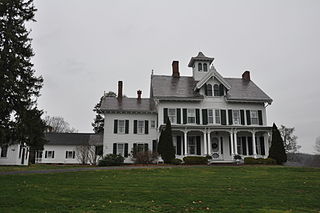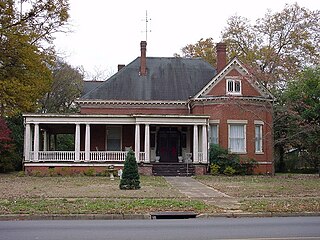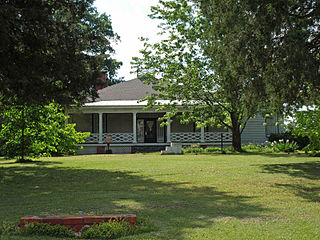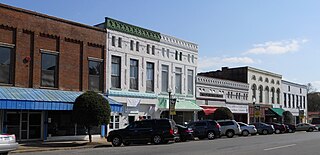
Rosemount is a historic plantation house near Forkland, Alabama. The Greek Revival style house was built in stages between 1832 and the 1850s by the Glover family. The house has been called the "Grand Mansion of Alabama." The property was added to the National Register of Historic Places on May 27, 1971.

The Goode–Hall House, also commonly known as Saunders Hall, is a historic plantation house in the Tennessee River Valley near Town Creek, Alabama. It was added to the National Register of Historic Places on October 1, 1974, due to its architectural significance.

Cohasset is a house in northeastern Hampton County, South Carolina about 5 mi (8 km) north of Hampton, South Carolina near the unincorporated community of Crocketville. It was built about 1873. It is north of U.S. Route 601. It was named to the National Register of Historic Places on July 24, 1986.

Belle Mont is a historic Jeffersonian-style plantation house near Tuscumbia in Colbert County, Alabama. It was added to the National Register of Historic Places on February 23, 1982, due to its architectural significance.

The David Lyman II House, also known as the Lyman Homestead, is a historic house at 5 Lyman Road in Middlefield, Connecticut. Built around 1860, it is among the best Gothic Revival structures in the greater Middletown area. The house is built in part on the foundation of a 1785 house that originally stood on the site. The 2-acre (0.81 ha) property containing the house and its outbuildings was listed on the National Register of Historic Places in 1986.

Miss Willie's House, also known as the Dr. Samuel Welch House, is a historic brick Queen Anne-style house in Talladega, Alabama, USA. It was built by Dr. Samuel W. Welch and his wife Ethel in 1907. Upon the deaths of Dr. Welch and his wife, the house passed to their daughter, Miss Willie Wallace Welch, who lived in the house until her death in 1997. The house is a contributing property to the "Silk Stocking District", a historic district designated in 1979 by the National Register of Historic Places in Talladega County.

Belle Mina, known as Belmina during the 19th century, is a historic plantation and plantation house in Belle Mina, Alabama, United States. Completed in 1826, the Late Georgian-style house was built for Alabama's second governor, Thomas Bibb.

Springfield Plantation House is the oldest wood-frame house in Fort Mill, South Carolina and was the site of one of the last meetings of the Confederate cabinet. It was listed on the National Register of Historic Places in 1985.

The Brewster Homestead is a historic house at 306 Preston Road in Griswold, Connecticut. Built about 1740, it is one of the oldest surviving buildings in the town. The house was owned by six generations of the Brewster family, and originally was the centerpiece of a farmstead of 250 acres (100 ha). The house was listed on the National Register of Historic Places in 2000.

The James H. Bibb House is a historic residence in Madison, Alabama. Bibb was an early landholder in Madison, one of the main proponents of its incorporation in 1869, and distant relative of Alabama's first two governors, William Wyatt Bibb and Thomas Bibb. In 1866, Bibb purchased 300 acres west of the Memphis and Charleston Railroad depot, farming corn and cotton himself on half of it and renting out the other half. He also owned a mercantile business and a steam-powered grist mill in the small town.

The Withers-Chapman House is a historic residence in Huntsville, Alabama. The house was built by Allen Christian circa 1835 as the center of a farm that would become one of the major dairy suppliers in central North Alabama. After Christian's death in 1849, the house was purchased by Augustine and Mary Withers. Former Governor of Alabama Reuben Chapman acquired the house in 1873, after his previous house nearby had been burned by departing Union soldiers in 1865. The house remained in Chapman's family from 1873 until 1971. The surrounding farmland has been sold off into suburban development, but the house retains a prominent position on a 2-acre lot on a hillside.

Rivercroft Farm is a historic farm complex on River Street in Fryeburg, Maine. The farm has been in the hands of the Weston family for many generations, and is one of the largest agricultural operations in Fryeburg. The centerpiece of the complex, on the south side of River Street, is an impressive Second Empire house built 1870-73, and believed to be designed by Portland architect Frances Fassett. It is a 2-1/2 story wood frame structure on a stone foundation. Its main block has a mansard roof; ells extend to the rear of the house that have gable roofs. The main facade is three bays wide, with a center entry flanked by paired sash windows, and a four-column porch extending across its width. The roof cornice and dormers have fine woodwork decoration typical of the Second Empire style.

The Jude–Crutcher House is a historic plantation house in Huntsville, Alabama. The house was built circa 1812 on land deeded that year to Samuel Echols. Echols sold 54 acres and the house to George Jude, Sr., in 1817. Jude died two years later, leaving the land to his son, George Jr. The younger Jude eventually acquired 800 acres and owned 31 slaves. Upon his death in 1873, the land stayed in the family until 1883. In 1906 David Crutcher, who had been born a slave on an adjacent plantation in 1851, purchased the house and 154 acres along with two other African-American men. The Crutchers operated a successful farm on their portion of the land, which was an extension farm for Alabama A&M University until the 1940s. Only 7% of African-American farmers in Madison County in 1910 owned their own farms. David died in 1924, and his wife, Lucy, died in 1943, although the house and land is still in the family.

The Ford–Countess House is a historic residence near Huntsville in Madison County, Alabama. Hezekiah Ford came to Madison County from Cumberland County, Virginia, in 1813, and began purchasing land on which to build a cotton plantation. He acquired the land on which the house stands in 1820, and built the two-story, brick I-house soon after. Ford died in 1839, and the land was owned by his wife, Nancy, until her death in 1844. Hezekiah's brother, John, then assumed ownership, and the plantation stayed in his family until 1904. It reached a peak of 280 acres, and the family owned 69 slaves in 1860. James W. Burcum owned the property from 1904 until 1911, when it was sold to Stephen H. Countess of Tuscaloosa. The Countess family still owns and farms the land, although the house has not been occupied since 1995.

The William Koger House is a historic residence near Smithsonia, Alabama. The house was built around 1830 by William and Martha Koger, planters from Virginia. The Kogers brought their native architectural form, the Tidewater-type cottage, with them to North Alabama. The house was the center of a 630-acre (255-ha) plantation, which included an island in the Tennessee River. After William's death, Martha continued to manage the farm until her death in 1892.

The Oaks is a historic residence near Tuscumbia in Colbert County, Alabama. Ricks came to North Alabama from Halifax, North Carolina in the early 1820s. He acquired a large plantation which he sold in 1826 and purchased nearby land. A log house had been built on the new property circa 1818, and Ricks built a new, larger house connected to it which was completed in 1832. The house remained in the family until 1966, and is still in use as a private residence.

Preuit Oaks is a historic plantation house near Leighton in Colbert County, Alabama. The house was built in 1847 by Dr. John S. Napier, on land originally owned by his father-in-law. The house and land were sold in 1851 to W. Richard Preuit, who developed the property into a large cotton plantation. At its peak in 1860, the plantation covered 1,500 acres ; following the Civil War, its productivity declined, and Preuit's holdings had depleted to only 400 acres upon his death in 1882. The house has remained in the family since.

Thornhill, also known as the Hade-Lewis House, is a plantation in Talladega County, Alabama, built beginning in 1835 by planter John Hardie. The property includes the Classical Revival house, a chapel, the servants' quarters, the plantation office, a barn, a horse racetrack and the family cemetery, along with the approach road. The main house is an I-house in plan, one room deep in front, two stories, with a rear ell. The facade is five bays wide and fronted by a central portico. The interior has a central hall plan, flanked by a parlor, a dining room and a library in the ell. A kitchen occupies the farther reaches of the ell.

The Hager Farm is a historic farmstead on United States Route 7 in southern Wallingford, Vermont. Its farmhouse, built about 1800, is one of the oldest in the community, and is regionally unusual because of its gambrel roof. The property was listed on the National Register of Historic Places in 1986.

The Twing Bucknam House is a historic house on United States Route 5 south of the main village of Windsor, Vermont. Built about 1840, it is a modest brick house with a combination of features that is unique to the state and the surrounding communities. It was listed on the National Register of Historic Places in 1996.

























